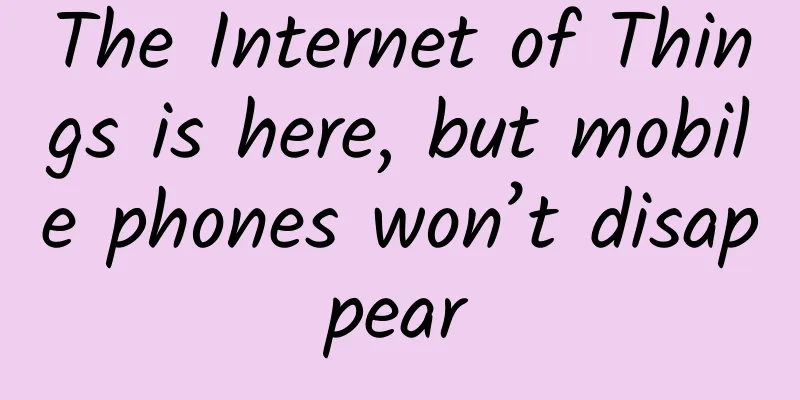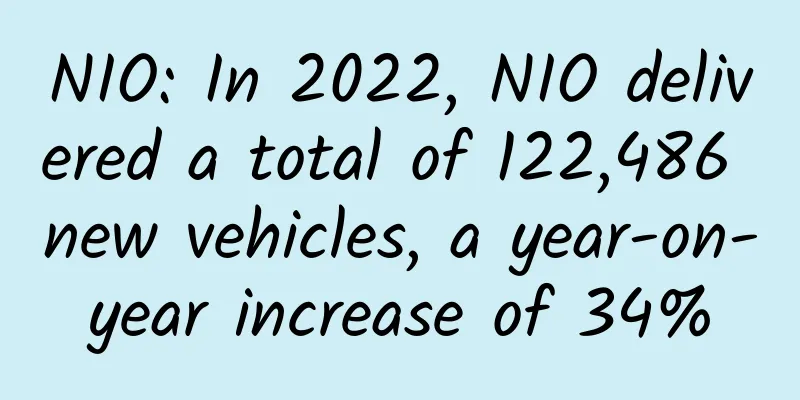The Internet of Things is here, but mobile phones won’t disappear

|
At this year's CES, Chinese manufacturers showed unprecedented enthusiasm, and Chinese audiences were even more outstanding. Last year, there were many Chinese people in Las Vegas casinos, but not many in the CES exhibition halls. This year, Chinese audiences can be seen everywhere, but the voices of Chinese people in casinos are not as loud as before. 2014 was a busy year for China's Internet and hardware startups. There were IPOs of companies such as JD.com, Alibaba, and Momo, a number of domestic mobile phone manufacturers such as Xiaomi sounded the clarion call for attacking Japanese, Korean, and American mobile phones, and hardware startup groups from Shenzhen, Beijing and other places attracted all kinds of attention. However, mobile phones, which used to be the absolute focus of attention, failed to attract more attention, and the media began to pay more attention to DJI drones, Xiaomi smart hardware and other content. CES 2015 undoubtedly provided strong evidence for this shift in attention. “Internet of Everything” has never been such a clear-cut theme of CES. This concept, which was repeatedly mentioned and questioned in 2014, was finally proven to be the next trend by upstream manufacturers in early 2015. Hardware connection continuesWiFi, Bluetooth, NFC, traditional hardware has never been connected in so many ways as it is today. These various connection methods can be seen as the prototype of the Internet of Things. When we talk about the Internet of Things and smart homes, Philips Hue is a pioneer that cannot be ignored. Unlike traditional WiFi transmission methods, Hue uses the more efficient and energy-saving Zigbee wireless communication technology. This smart lighting system, which was launched as early as the end of 2012, is now considered to be a very representative product. It is connected to smartphones, supports IFTTT, is bound to many applications, responds to environmental changes, creates atmosphere, and other ideas that have not become outdated. From the perspective of mobile Internet, Philips is not a suitable case. Like most European companies, Philips has not gained much in this wave. However, from the perspective of hardware connection, Philips is a typical example. Hue is naturally needless to say. At this year's CES, many of Philips' acoustic products were given more connection features. In addition to more connection possibilities, there are actually more scalability. Fidelio B5 is a new home theater audio product launched by Philips at CES. The speaker system consists of a host and two wireless detachable speakers, and these three components can be used as separate Bluetooth speakers, and there is also NFC pairing. Its intelligence lies in its patented algorithm for spatial calibration. In a home theater system, separate speakers need to be accurately positioned to obtain the best sound effects, but Fidelio B5 can be placed anywhere in the room, and the calibration algorithm automatically adjusts the sound field. This actually corresponds to the hardware beginning to "understand" the environment. At the same time, it also won the CES Home Theater "Best Innovation Award". ShoqBox Mini (BT2200) represents another way of thinking. In addition to "understanding" the environment, many smart hardware actually need to "adapt" to the environment. Its waterproof capability and special reinforced structure allow it to adapt to various climates and environments. It can even float on the water. The built-in microphone allows it to be used as an extension of the mobile phone for hands-free calls. It has long been a trend to give acoustic devices more and faster connection features with smart devices and make them the extension of smart devices. This trend is also reflected in Philips' other two CES award-winning products, the Fidelio M2 Bluetooth headset and the Philips FL3X Bluetooth speaker, both of which are such products. The connection feature is placed at the same marketing level as the sound quality. In fact, the same idea was also used in many of the headphone and audio products released by Samsung last year. For the entire Internet of Things industry, Philips Hue and the acoustic products exhibited at this year's CES are more like a small introduction. Europe, which is considered to be the Internet depression, is like this, and the United States and East Asia are even more keen to promote this trend. The direction of the wind blown by the giants
Samsung is undoubtedly the consumer electronics manufacturer most willing to actively promote the Internet of Things. In 2014, the Korean manufacturer, which did not develop smoothly on the mobile phone side, tried to take the lead in the field of the Internet of Things and became the beneficiary of two trends. In the last wave of mobile Internet and smart phones, Samsung leapt from the quasi-first-class mobile phone echelon to the industry leader. In this Internet of Things momentum, Samsung's response was even faster than last time, and it shouted the slogan "Infinite possibilities of the Internet of Things".
Qualcomm occupies the upstream and is also a beneficiary of the mobile Internet and smartphone boom. Similar to Samsung, Qualcomm's slogan this time is "Internet of Everything". In the smart home model room specially opened by Qualcomm, partners from the Internet of Things Alliance AllSeen, including Haier, LG, and LeTV, together with Qualcomm, have transformed the entire room into a "smart home demonstration field" where all electricity flows and is connected to the network.
Intel is a different story. In the field of Internet of Things, Intel has shown great enthusiasm. Even at this CES, Intel released the fifth-generation Core chip. In the foreseeable future, the PC chip market represented by Core chips and the server chips and solutions represented by Xeon chips will still be the main source of Intel's future profits. However, Intel's main push this time is the Edison and Curie platforms based on the Quark microprocessor. The former can be made the size of a stamp, and the latter can be made the size of a button, precisely targeting the field of Internet of Things and wearable devices. Therefore, Intel's layout is that Xeon corresponds to enterprise-level servers, Core corresponds to PCs, Atom corresponds to low-end PCs, tablets and mobile phones, and Quark corresponds to the Internet of Things and wearables. If just mentioning these three giants is not enough to illustrate the problem, then looking at the list of the AllSeen Internet of Things Alliance, you will find that its well-known member companies and institutions can fill up a full A4 page. Whether it is the subtle actions of a single manufacturer or the change in direction of the giants, it has actually been made very clear that in mid-2015, the Internet of Things has become a major trend created by the joint efforts of manufacturers. Trends don’t necessarily mean those who follow me will prosper.Nokia is undoubtedly the best example of the lessons learned from the past when it missed the mobile Internet. Its clinging to Symbian and its wrong investment in WP are both lessons. Intel and Microsoft were also negative examples. Therefore, with the rise of the mobile Internet, the craze for commenting has particularly valued "trends". To some extent, trends are a general concept, and their breadth is even greater than that of "Internet thinking". Just as many people have "Internet anxiety" and are afraid of being abandoned by the Internet, I believe many people also have this kind of "trend anxiety". In the Internet of Things, a trend that everyone can see now, almost all companies seem to be ready. Samsung, Philips, Haier and other home appliance companies have already made clear statements last year or even earlier, and Xiaomi has recently shifted its product and marketing focus to smart hardware. Google acquired Nest and Apple released Homekit. However, for now, no company's product has had an immediate impact on our lives. The products of Samsung and other manufacturers moving towards the Internet of Things are more like a determination to become industry leaders again, and they also have the idea of developing their own Tizen OS. Haier's transformation is a decision and warning from the company's top management. Philips' product line is a natural extension and evolution of the past, and Xiaomi's layout in this regard is more of an investment and alliance approach, and its path is more circuitous. What is mentioned above is the relatively large home appliance in the Internet of Things. Together with the wearable devices that have been very popular in the past two years and the Internet of Vehicles, it basically covers the large range of the Internet of Things. At present, in the field of the Internet of Things, we have not seen disruptors like Apple and Google. Home appliance manufacturers are more likely to embrace the Internet rather than self-disruption, which is of course the right direction. According to the unanimous voice at this CES, and the initial stage of the Internet of Things, which has not yet achieved any results, the trend set by manufacturers is more likely to be a "peaceful evolution" rather than a business history case similar to the rise of Apple and the decline of Nokia. After all, most manufacturers are already like Philips, ready to go when the Internet of Things has not yet flourished. The core of mobile Internet is the popularization of 3G and Wi-Fi, as well as various connection methods, which provide efficient network conditions and information transmission for hardware, and the iOS and Android ecosystems give smartphones more powerful capabilities, improving efficiency in all aspects. Among them, smartphones are at the absolute core of mobile Internet. The Internet of Things is different. It covers too many product lines. In addition to Android and iOS, there are also potential systems such as Samsung's Tizen OS and LG's Web OS. Manufacturers with their own ideas will not let the Internet of Things see the same situation as before, when Android and iOS dominated smartphones. Another key issue is that without the Internet, the utility of smartphones will be greatly reduced, as will PCs and tablets. For these products, the Internet is their other half. However, it is different for smart homes or car networking. Without the Internet, the cooling effect of air conditioners will not deteriorate, and the fuel consumption of cars will not increase. At present, the Internet is a timely help for mobile Internet products and icing on the cake for IoT products. As a result, it is unthinkable to convince consumers to replace home appliances like replacing smartphones, and the practicality and necessity of current smart home products have not yet reached the point where consumers must replace them, unless manufacturers are so crazy as to make connecting to the Internet a necessary condition for air conditioning refrigeration.
For air conditioners, the significance of the Internet and operating systems is far less than the cooling effect. Many years later, we may see Xiaomi's sales exceed Gree's, but we may not see Midea's air conditioners equipped with MIUI exceed Gree's market share. Even in the age of the Internet of Things, smartphones still reign supremeWe mentioned "trend anxiety" earlier. When some people see trends, they lose their judgment ability in their excitement. For example, recently, many people have begun to praise the Internet of Things and criticize smartphones after watching CES closely or from a distance. One of the arguments is that at this CES, exhibitors such as Samsung and Sony did not release any mobile phones, but released products such as TVs and washing machines, which is enough to show that their focus is shifting. Of course, there is no problem in isolation, but looking back in the past, we will find that CES is called the Consumer Electronics Show, and it covers a very broad field, and smartphones are only a part of it. More importantly, manufacturers such as Samsung and Sony are more accustomed to releasing their flagship smartphones at MWC and IFA after CES. Judging trend changes cannot be based on a single exhibition. Even from CES, we cannot judge only by whether new mobile phones are released. In fact, if we look closely, smartphones will still play a pivotal role in the era of the Internet of Things. For example, the Qualcomm smart home model room mentioned above and some Philips products all need to be connected to smartphones or tablets to become "smart". Why does the Internet of Things still need smartphones? The reason is that the computing power is insufficient and the smartphones are not smart enough. In most IoT products, the mobile phone still plays the role of computing terminal and controller. This cooperation between IoT devices and smartphones will not change in the near future. However, it can also be foreseen that with the enhancement of sensor technology, the addition of microprocessors and various functional modules, IoT products must develop in the direction of "de-smartphoneization". When IoT devices are basically independent of mobile phones to achieve "intelligence", it will not be too late to criticize smartphones. Even if this day comes, smartphones should become a stable and sustainable market similar to the current PC. Although there is no significant growth and the profit margin is very low, there is still meat to eat and soup to drink. And, just as smartphones and tablets cannot replace PCs, there will be no products that can replace smartphones in the short term. You can't complete social networking, information, communication, payment, daily shopping and other things on a refrigerator. It is true that there has been little innovation in smartphones in the past two years, and this will become the norm in the future, with the gradual evolution of specifications and some minor improvements. There is no way around it, this is inevitable for the development of the industry. In addition to the larger screen and better lens, the iPhone 6 & 6 Plus, which have not made much progress, can still create quarterly sales records, and Xiaomi's rising valuation and sales expectations also show that the demand in this market is still strong. Samsung's pace of new product releases at CES and its recent market performance cannot be proven to be evidence of a bleak future for smartphones under the Internet of Things. |
<<: Gaming on smartwatches: Break through or stop
>>: WeChat opens JS SDK, giving browsers another lesson
Recommend
Wang Peng of Yihui Zhongmeng: Offline big data - the next outlet for intelligent technological innovation
[51CTO.com original article] The WOT 2016 Big Dat...
How much does it cost to produce the Xianyang wedding banquet mini program? Xianyang wedding banquet applet production price inquiry
How much does it cost to produce the Xianyang wed...
UK car production falls in October 2016 due to Brexit
According to Reuters, British car production fell...
Baidu bidding promotion planning, what should we pay attention to in the system of Baidu bidding promotion plan?
A high-quality bidding promotion plan is the begi...
Youzi operates two hours a day and earns more than 1,000 yuan a day.
This project was created when I was researching p...
Xiaomi and Huawei are almost breaking their heads for these parameters
Compared with the rapid growth of the mobile phon...
Can flying cars successfully take off into the sky?
In the technology circle, flying cars have always...
Card-Film and Television Commentary Training Camp 3rd Session, 130 practical lessons, film and television commentary, technical Q&A
Card-Film and Television Commentary Training Camp...
The more you walk, the lower your risk of death?
Insufficient physical activity affects more than ...
New weapon against cancer! China Spallation Neutron Source: making the microscopic world “visible”
From "a piece of paper plan" to the cre...
How to learn dubbing? Dubbing training video tutorial, teach you to learn dubbing from scratch
How to learn dubbing? Dubbing training video tuto...
A "weapon" for mobile game developers: Introduction to Apple's App Thinning feature
At the Apple WWDC15 conference that ended on June...
How much does it cost to customize a hardware app in Anyang?
The main factors affecting the price of mini prog...
The Handbook of Life Counterattack
The Handbook of Life Counterattack Thinking Selec...
Phenomenal SUV! Model Y price cuts have just begun, from luxury to civilian, a crushing blow?
1. This report comprehensively discusses the Tesl...

![[Creative Cultivation Program] "From fish to humans" has more evidence, is the human middle ear transformed from fish gills?](/upload/images/67f25aa89805a.webp)







